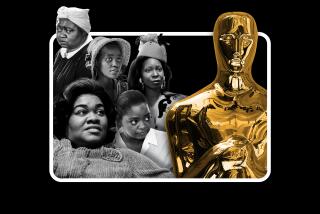Films that look back at post-war America like ‘Fences’ and ‘Hidden Figures’ are digging deeper this year
Stop by the movie theater this awards season and you might wonder exactly what decade we’re living in. From “Fences” to “Hidden Figures,” “The Founder” to “Loving” — and even on some level “20th Century Women” — the mid- to late-20th century remains compelling turf to filmmakers. Consider the number of Oscar nominees set at least partially in the 1950s just last year: “Carol,” “Brooklyn,” “Trumbo” and “Bridge of Spies.”
Yet what’s interesting about this year’s crop of films is that the stories are shifting. They seem to be digging a little deeper into that era and offering up details we haven’t seen before, particularly in the areas of women and African Americans.
“You’ve seen the fire hoses [on protesters] and the KKK and the dogs, that type of thing in cinema forever,” says Ted Melfi, director of “Hidden Figures,” about the roles key black women played in the NASA program in the 1960s. “What you haven’t seen is the corporate racism, the everyday effects of segregation in the workplace.”

Ruth Negga discusses finding the right accent, attitude and speaking voice for the fact-based historical drama “Loving.”
Producer Peter Saraf, whose “Loving” examines the lives of Mildred and Richard Loving, a Virginia couple whose interracial marriage was ultimately litigated up to the Supreme Court in 1967, agrees that we’re getting to a more micro-level of stories . “We might expect the men in white cloaks or the burning crosses, but [“Loving”] is more about emotional violence: the emotional violence of a pregnant woman thrown in jail for the weekend, the emotional violence of where is the next moment of legal action against us going to come from?” he says.
Historically, films have trended toward whitewashed versions of history, from the Old West cowboy myths to our understanding of the roles nonwhite men played in the 20th century. The question remains, though: As we gain a greater understanding of the diversity of those periods, will we start seeing a more realistic version of history?
“The film business has been very good for the first century of its existence at telling stories from a straight white male perspective,” Saraf says. “We’re only starting to open up to the business of a more inclusive body of storytellers. That will inevitably lend itself to a more diverse palette of stories — and there will be more perspectives, so you don’t always have to have the white protagonist and we can tell the stories of all people, which is exciting for the culture at large.”
And by telling stories that are more diverse in both big ways and small, says “20th Century Women” director Mike Mills, we are able to share a more truthful version of the world. “People we haven’t normally seen doing things we don’t normally see them do goes hand-in-hand with a story being more realistic,” he says.
As he notes, his film features a mom who aspired to be a pilot. “Even in her ‘mom-ness’ there’s a lot of dimension I gave her that traditional filmmaking doesn’t really like,” he says. “Commercial filmmaking is slightly allergic to that.”
Yet if this is coming to a boil now, it’s less about what went on back then than about our current place in history, says “The Founder” production designer Michael Corenblith, whose film follows the rise of McDonald’s magnate Ray Kroc in the 1950s and ’60s.

Michael Keaton, Nick Offerman and John Carroll Lynch star in “The Founder.”
“Period films ultimately tell you more about the period in which they were made than the period they depict,” he says. “A picture about ‘High Noon’ tells you more about America in the 1950s than America in the 1870s. We cannot escape the little chunk of the space-time continuum we ride on, and many things are not going to be revealed until time does its job.”
One thing seems clear, though: Now that movies like “Hidden Figures” and “Loving” are bringing to light major historical facts that had remained out of general sight for so many years, it’s hard to imagine Hollywood turning back.

“I no longer use the word ‘diverse,’” Melfi says. “I use ‘truth.’ There’s no good reason to say in a movie that there was no black person, or Asian person, or Latin person around — it’s just untrue.”
“‘Loving’ happened within my lifetime,” Saraf says. “That feels like very current history. We’re still struggling with these issues today, but I do think we will continue to tell these stories, reinterpreted through the modern perspective. The particularly fertile periods of history, I think, will remain relevant — and as our culture continues to make history every day, we create new and exciting stories to tell.”
ALSO
Old Hollywood’s Lew Ayres served his country as a conscientious objector
With Brad Pitt and Marion Cotillard as your stars, why not make their costumes seductive?
Listing a winter’s worth of movies
Through ‘Silence,’ Martin Scorsese examines his own spiritual journey
More to Read
From the Oscars to the Emmys.
Get the Envelope newsletter for exclusive awards season coverage, behind-the-scenes stories from the Envelope podcast and columnist Glenn Whipp’s must-read analysis.
You may occasionally receive promotional content from the Los Angeles Times.






